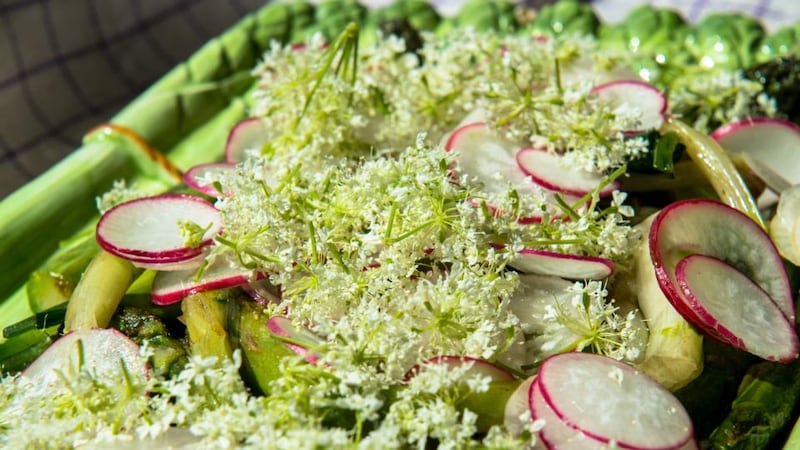It’s not ladylike to lose one’s lunch in the fjord. So I’m planning a firm “no thanks” to the trip on a Viking boat. I have the sea legs of a potato; turf over surf, please. But on a sunny afternoon in Roskilde in northern Denmark Rikke Johansen has just talked me into clambering down into a replica Viking boat. I slot my long, thin wooden oar into its rope notch and heave-ho with the rest of the crew/group of amused journalists. A Viking boat, she explains, snakes and worms its way through the waves rather than bashing and bobbing along. Their suppleness is down to the way they’re made. Whether it’s the rowing or the laughing, ducking the sail or the ingenuous design, those choppy waves are having none of their usual effect. I’m in touch with my inner Viking.
They sometimes joke at the Viking Ship Museum at Roskilde that they are the smallest museum in the world “because we have just five things”.
These are the five Viking boats discovered on the seabed and salvaged piece by painstaking piece more than 50 years ago. One of them, the Sea Stallion, was made in Dublin and a replica was sailed back to Dublin in 2007. In Roskilde they built a modern concrete and glass building to house the ships’ remnants. You won’t find staff wearing Viking costumes. There isn’t a horned helmet in sight.

And the food is the latest visitor experience to be Viking-ed in Roskilde. A year of research went into trying to figure out the Viking diet, curator Louise Kaempe Henriksen explains. The work was in response to complaints from visitors. The food project got curators thinking about how people go to museums to look at things and read information but come away feeling like they haven’t experienced anything.
Say “Viking meal” and people picture someone gnawing on a bone, dribbling meat juices down their tunic. But this cafe is all sleek lines, more Viking hipster than ye olden days recreation. “New Nordic hotdog” anyone?
The rules are simple. The menu only allows foods that would have been available from the Stone Age to the 12th century. That means no chips (potatoes weren’t in Europe until the 1600s) or tomatoes. But also no Jerusalem artichokes, cauliflower, rhubarb or asparagus, all central planks of Nordic food.
The idea is to “generate stories in people’s heads,” Rikke Johansen explains, like trying to imagine what it must have been like for a Viking to come home and tell his friends and family what it was like to eat an orange.
They’re also allowed to serve foods that the Vikings might have brought back from overseas. It’s typical of Danish attitudes to package Vikings as early gastro-tourists. You can see everything through the prism of the country’s vibrant new food culture. Copenhagen restaurant Noma may have slipped from best restaurant in the world slot (Spanish restaurant El Celler de Can Roca took the crown this year) but the “Nomanomics” around having the world’s best restaurant for three years are fascinating.
Copenhagen has had a 12 per cent increase in visitors in the past two years, according to Kasper Fogh of the Danish Food Project. Last year 5,000 new jobs were created in the restaurant scene. And one in three tourists comes to Denmark to eat dinner in a particular restaurant.
The night before our Viking trip we ate 10 courses of spectacular food at the beautiful Dragsholm Slot, a 12th-century castle on the Lammefjord on the coast, about 90 minutes drive from Copenhagen. Chef Claus Henrikson and his team turned potatoes into tagliatelle (through the magic of a Japanese mandolin crossed with a pasta maker), fermented raw squid and sliced purple “vintage” carrots (they spend two years in the sandy soil of this reclaimed former fjord) into ribbons. It was a symphony of vegetables and wild foods.
Earlier the castle’s ranger, Jorgen Stoltz, took us on a forage of the forest and seashore. We saw sea kale, scurvy grass, wild garlic and woodruff (which makes a mean Schnapps). There was even, surprisingly, the beginnings of samphire which Stoltz met with a shout of surprise. “Oh this has come. It’s not usually here until July. It’s such a strange year.”
Wedding groups who use the castle (with its own chilly chapel) can forage for ingredients for the feast if they like. I slept in one of 20 rooms in a refurbished outbuilding which looks almost like a train station, with light flooding the gorgeous rooms from both sides. The next morning a run to the beach looped back past day-glo yellow fields of rapeseed.
As well as the hotel restaurant Dragsholm has a bistro where anyone can eat, with an €11 main course an effort to keep this luxurious place open to anyone who happens to be passing.
The castle is close to Denmark’s celebrity farmer Soren Wiuff. The 57-year-old Dane has been farming on the Lammefjord for 35 years and is famed for his white asparagus. Twenty years ago he was selling his food to supermarkets, he says. “There was no connection between me and them.”
In the 1980s he started selling to restaurants. His farm is the cradle of Denmark’s restaurant revolution. The feedback from the chefs was immediately positive. “It makes me proud. If farmers’ self esteem is very high it’s not a problem feeding the world,” Wiuff says simply. And he’s a pragmatic dreamer. The farm is not organic. A litre of Roundup will keep his field weed-free, he explains, a job that would take 800 litres of tractor diesel to achieve mechanically. In the asparagus fields he piles up the sandy soil into four-foot ridges. As soon as the head of the asparagus appears, like a thumb tip, it’s harvested by hand, its long thick stem still white below the surface.
In the farm’s experimental kitchen we tuck into a feast of asparagus including a delicious barley and asparagus risotto. He’s even made an asparagus beer, from the 10-year-old roots, in a collaboration with the Herslev brewery, which was set up by Tore Jorgensen nine years ago. Denmark had two big brewers back then. There have been 120 new breweries set up since.
A former pig farmer, Jorgensen grows most of the barley used in his beer on his farm. Making beer was very common on farms in the past, he explains. "The farmer who made the best beer got the best workers because food and beer were part of the wages." Seems that those discerning foodie Danes go back a long way.
Catherine Cleary travelled to Denmark as a guest of the Danish Food Project
Dragsholm Slot, Dragsholm Alle, 4534 Horve, dragsholm-slot.dk
Roskilde Viking Ship Museum, Vindeboder 12, 4000 Roskilde, Vikingeskibsmuseet.dk
Herslev Brewery, Kattingevej 8, 4000 Roskilde, herslevbryghus.dk
















